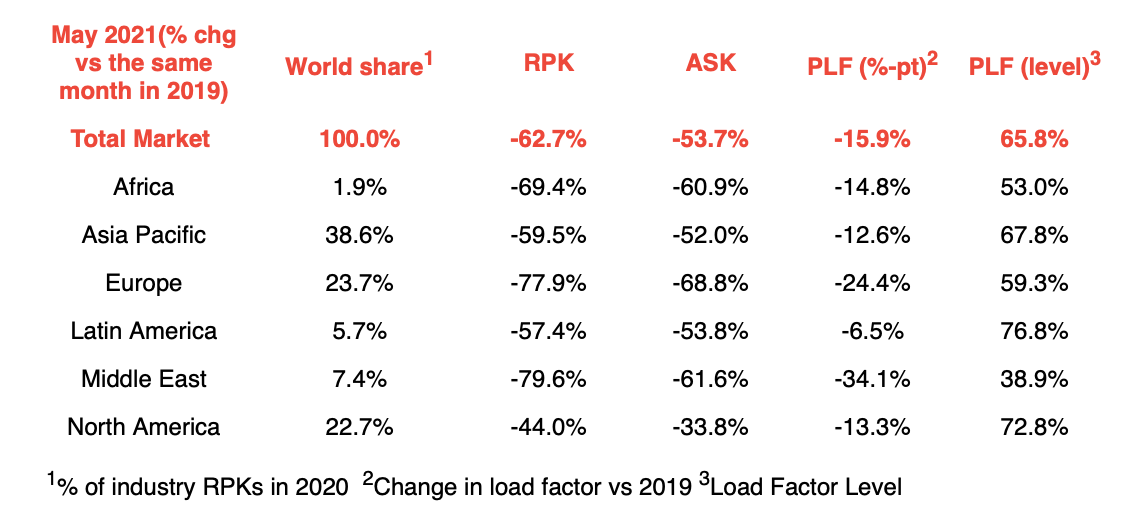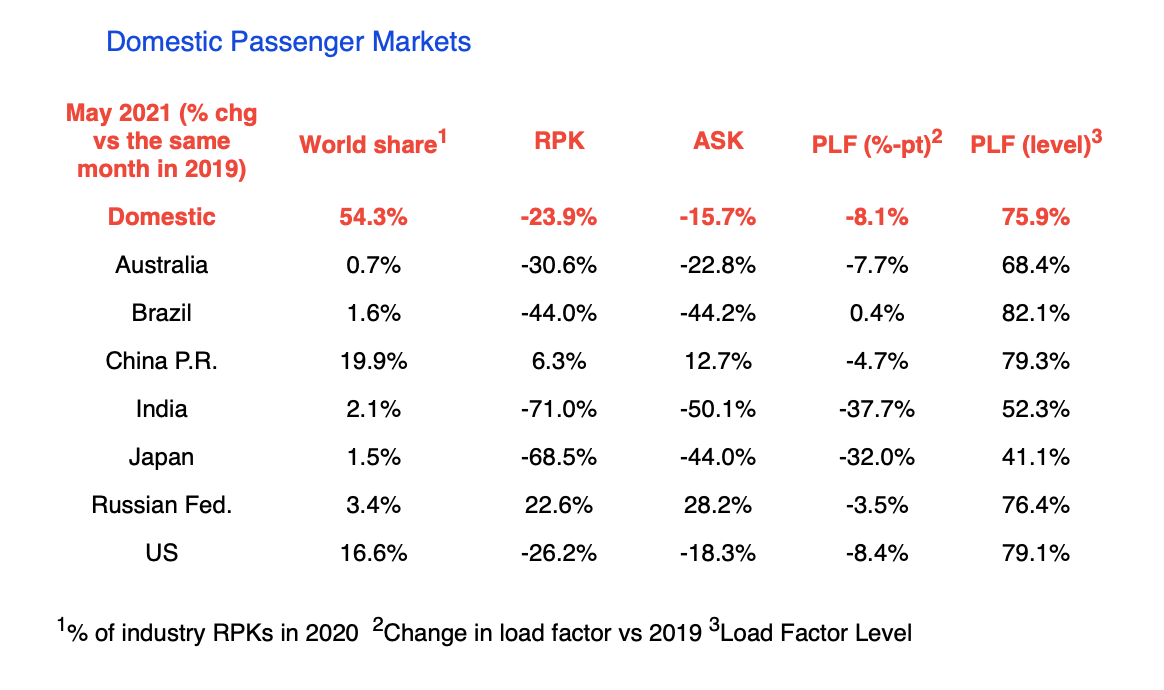May shows passenger traffic increase in most regions
The International Air Transport Association (IATA) has released figures that show marginal improvements in both domestic and international travel in May 2021, though numbers are still down drastically from pre-pandemic, and international travel continues to be restricted because of global travel restrictions.
Whereas normally figures are compared to the previous year, in this case the following figures are compared to those of 2019, because of the extraordinary impact of the pandemic in 2020.
Total air travel demand in May was down 62.7% vs May 2019, which is an improvement over April, which showed a decline of 65.2%
International passenger demand in May was 85.1% down from May 2019, up from from the 87.2% decline recorded in April.
Total domestic demand in May 2021 was down 23.9% versus May 2019, again a slight improvement from April’s figure of -25.5%.
“We are starting to see positive developments, with some international markets opening to vaccinated travelers. The Northern Hemisphere summer travel season is now fully arrived. And it is disappointing that more governments are not moving more rapidly to use data to drive border opening strategies that would help revive tourism jobs and reunite families,” said Willie Walsh, IATA’s Director General.

Declines in international traffic for airlines by region May vs April, 2021 vs 2019
Europe: May traffic was down 84.7% vs 87.7% in April. Capacity in May 2021 vs 2019 was down 75.7% and load factor was at 52.9%
Asia-Pacific: The only region to not improve internationally in May, due to the continuation of firmly closed borders, international traffic fell 94.3% in May compared to May 2019, while in April that drop had been 94.2%. Capacity was down 86.4% and the load factor sank 45.5 percentage points to 33.2%, the lowest among regions.
Middle East: This region saw an 81.3% demand drop in May compared to May 2019, slightly better than the 82.9% decrease in April. Capacity was at 63.7%, and load factor fell 35.3 percentage points to 37.7%.
North America: Demand in May fell 74.4% compared to 2019 vs 77.6% decline in April. Capacity was 58.5%, and load factor dropped 32.2 percentage points to 51.7%.
• Latin America: May saw a 75.1% drop in demand vs 2019, which was a noticeable improvement from the 80.9% decline in April. May capacity was down 69.9% and load factor decreased 14.6 percentage points to 69.5%, the highest load factor among the regions for the eighth consecutive month.
• Africa: International traffic fell 71.4% in May versus May of 2019. This was an improvement on April’s 75.6% decline. May capacity declined 61.8% versus May 2019, and load factor dropped 16.9 percentage points to 50.2%.
 Of note: India’s domestic traffic fell drastically in May vs April, duty to the surge in the highly contagious Delta variant. Brazil, meanwhile, showed a large rebound in May as travel restrictions eased.
Of note: India’s domestic traffic fell drastically in May vs April, duty to the surge in the highly contagious Delta variant. Brazil, meanwhile, showed a large rebound in May as travel restrictions eased.
Walsh stated: “To paraphrase an old saying, when you think that all you have is a hammer, every problem looks like a nail. Too many governments continue to act as if the only tool in their anti-COVID-19 arsenal is a blanket border closure or an arrival quarantine. In fact, research from leading medical organizations around the globe confirms that vaccinated travelers pose very little risk to the local population(i) while data show that pre-departure testing largely removes the risk of unvaccinated travelers importing COVID-19(ii).
“It is long past time for governments to start responding to this information with more nuanced data-driven risk-based strategies. These will minimize the chance of importing COVID-19 while allowing the world to reopen to travel and all the opportunities it brings to reconnect with loved ones, to realize business opportunities, to explore the world or take a well-deserved vacation,” said Walsh.










